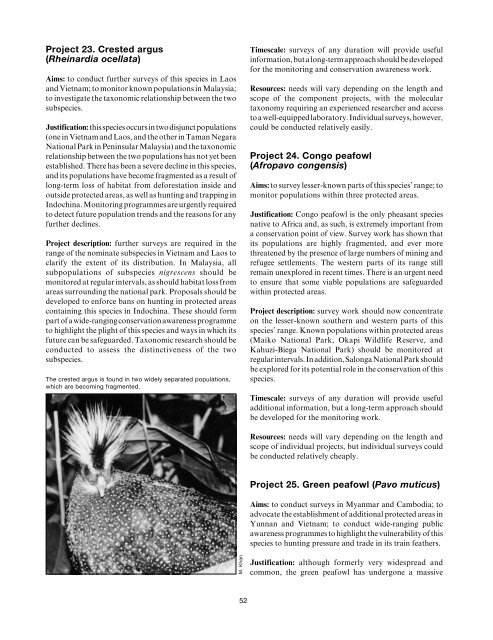Pheasants: Status Survey and Conservation Action Plan ... - IUCN
Pheasants: Status Survey and Conservation Action Plan ... - IUCN
Pheasants: Status Survey and Conservation Action Plan ... - IUCN
You also want an ePaper? Increase the reach of your titles
YUMPU automatically turns print PDFs into web optimized ePapers that Google loves.
Project 23. Crested argus<br />
(Rheinardia ocellata)<br />
Aims: to conduct further surveys of this species in Laos<br />
<strong>and</strong> Vietnam; to monitor known populations in Malaysia;<br />
to investigate the taxonomic relationship between the two<br />
subspecies.<br />
Justification: this species occurs in two disjunct populations<br />
(one in Vietnam <strong>and</strong> Laos, <strong>and</strong> the other in Taman Negara<br />
National Park in Peninsular Malaysia) <strong>and</strong> the taxonomic<br />
relationship between the two populations has not yet been<br />
established. There has been a severe decline in this species,<br />
<strong>and</strong> its populations have become fragmented as a result of<br />
long-term loss of habitat from deforestation inside <strong>and</strong><br />
outside protected areas, as well as hunting <strong>and</strong> trapping in<br />
Indochina. Monitoring programmes are urgently required<br />
to detect future population trends <strong>and</strong> the reasons for any<br />
further declines.<br />
Project description: further surveys are required in the<br />
range of the nominate subspecies in Vietnam <strong>and</strong> Laos to<br />
clarify the extent of its distribution. In Malaysia, all<br />
subpopulations of subspecies nigrescens should be<br />
monitored at regular intervals, as should habitat loss from<br />
areas surrounding the national park. Proposals should be<br />
developed to enforce bans on hunting in protected areas<br />
containing this species in Indochina. These should form<br />
part of a wide-ranging conservation awareness programme<br />
to highlight the plight of this species <strong>and</strong> ways in which its<br />
future can be safeguarded. Taxonomic research should be<br />
conducted to assess the distinctiveness of the two<br />
subspecies.<br />
The crested argus is found in two widely separated populations,<br />
which are becoming fragmented.<br />
Timescale: surveys of any duration will provide useful<br />
information, but a long-term approach should be developed<br />
for the monitoring <strong>and</strong> conservation awareness work.<br />
Resources: needs will vary depending on the length <strong>and</strong><br />
scope of the component projects, with the molecular<br />
taxonomy requiring an experienced researcher <strong>and</strong> access<br />
to a well-equipped laboratory. Individual surveys, however,<br />
could be conducted relatively easily.<br />
Project 24. Congo peafowl<br />
(Afropavo congensis)<br />
Aims: to survey lesser-known parts of this species’ range; to<br />
monitor populations within three protected areas.<br />
Justification: Congo peafowl is the only pheasant species<br />
native to Africa <strong>and</strong>, as such, is extremely important from<br />
a conservation point of view. <strong>Survey</strong> work has shown that<br />
its populations are highly fragmented, <strong>and</strong> ever more<br />
threatened by the presence of large numbers of mining <strong>and</strong><br />
refugee settlements. The western parts of its range still<br />
remain unexplored in recent times. There is an urgent need<br />
to ensure that some viable populations are safeguarded<br />
within protected areas.<br />
Project description: survey work should now concentrate<br />
on the lesser-known southern <strong>and</strong> western parts of this<br />
species’ range. Known populations within protected areas<br />
(Maiko National Park, Okapi Wildlife Reserve, <strong>and</strong><br />
Kahuzi-Biega National Park) should be monitored at<br />
regular intervals. In addition, Salonga National Park should<br />
be explored for its potential role in the conservation of this<br />
species.<br />
Timescale: surveys of any duration will provide useful<br />
additional information, but a long-term approach should<br />
be developed for the monitoring work.<br />
Resources: needs will vary depending on the length <strong>and</strong><br />
scope of individual projects, but individual surveys could<br />
be conducted relatively cheaply.<br />
Project 25. Green peafowl (Pavo muticus)<br />
Aims: to conduct surveys in Myanmar <strong>and</strong> Cambodia; to<br />
advocate the establishment of additional protected areas in<br />
Yunnan <strong>and</strong> Vietnam; to conduct wide-ranging public<br />
awareness programmes to highlight the vulnerability of this<br />
species to hunting pressure <strong>and</strong> trade in its train feathers.<br />
M. Khan<br />
Justification: although formerly very widespread <strong>and</strong><br />
common, the green peafowl has undergone a massive<br />
52
















